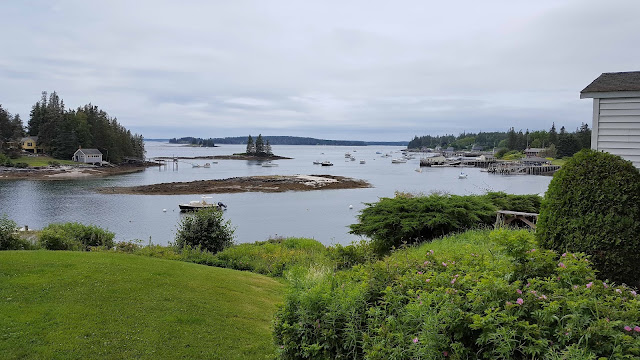Ange and I couldn't resist having our picture taken with the "lobster bear"
Tanks, tanks everywhere, full of lobsters. This picture is of one side of the pound - the other has just as many tanks. That large ladder in the center goes up to a big dinning hall, just in case you aren't a true Mainer and don't want to eat outdoors. (note what both men in the picture are doing....)
The "working" tank where you pick your lobster is brimming with lobsters.
The working area behind the tank.
There is also the counter where you order your cooked meal. Didn't get a picture of that. Maybe next time - we definitely want to go back and eat, hopefully while Ange and Ray are still here. We had just had a really good haddock and chips lunch at a little diner in Belfast. Ray said their goal for this trip is to eat lobster and blueberries!!
In the back is an outdoor dining area, plus a dinghy dock. Luke and I will be able to zip right over the next time we're in Belfast.
On the side of the shop, each A/C unit has workers gloves drying in the warm air.
Just past Belfast is Ft Knox and the Penobscot Narrows Bridge and Observatory. Built in 2006, one of the towers has an observatory at the top. The towers are high, 437 ft, over 140 feet taller than the Statue of Liberty. An elevator whisks you to the top in less than 1 minute.
Borrowing from Wikipedia, the bridge was "constructed recently using a cradle system that carries the strands within the stays from bridge deck to bridge deck, as a continuous element, eliminating anchorages in the pylons. Each epoxy-coated steel strand is carried inside the cradle in a one-inch steel tube. Each strand acts independently, allowing for removal, inspection and replacement of individual strands. The cable-stay system was designed with a system that uses pressurized nitrogen gas to defend against corrosion.
In June 2007, six reference strands within three stays were replaced with carbon fiber strands – a first in the US. Monitoring on the strands will evaluate this material for future use in bridge designs"
If you want to read more about it,visit
Ft Knox is also located at the Penobscot Narrows.
During both the Revolutionary War and the War of 1812 British ships entered the Penobscot and claimed the area. The USA decided some defense was a good idea and by 1844 had started the massive fort. The fort saw only 2 periods of military activity, the Civil War and the Spanish-American War, but no enemy ships ever entered the Penobscot during these periods.
Last stop of the day was Castine, home of the Maine Maritime Academy. No lobster pound on the dock, but we did find ice cream and the Dyce Point lighthouse.
The next day we took a sailboat excursion along the coast to see the towns from the water. Latitudes is a lot slower than the car, so we only got as far as Camden. As Luke and I took Latitudes to the dock to pick up Ange and Ray, we spotted (couldn't miss....) Evivva on the dock. This is the yacht with the helicopter. Got a good picture this time.
It was a sunny, calm day and we took full advantage of it. Our guests took much of the ride on the bow of the boat, great for taking in sun and postcard perfect pictures. First, Ray.
Ange and I had to get in on the act, too.
The background here is the Rockport harbor. It has a cute little park with a lobster pound and the town climbing up the hill behind it.
Her lighthouse, the Curtis Island lighthouse, is quaint, too.
Camden was next, her harbor full of beautiful old sailing vessels.
We anchored for lunch and then slowly made our way back to Rockland. Very slowly, as the sun was in front of us and the wind had picked up. Both of these made it much more difficult to see the lobster
floats. But we didn't snag any of them! Ange caught this picture of us leaving the dock after dropping them off. Luke is at the helm and I am cleaning up the dock lines and such. It was actually a very tricky maneuver to get away from this "U" shaped dock with the wind (gentle, fortunately) blowing us into it. We used a forward spring line, and volunteered Ray to hold the bow off the dock as we pivoted the stern away from the dock.
Today is very windy with scattered showers. We are anchored out, relatively sheltered, riding out the day. More exploring tomorrow.
























































